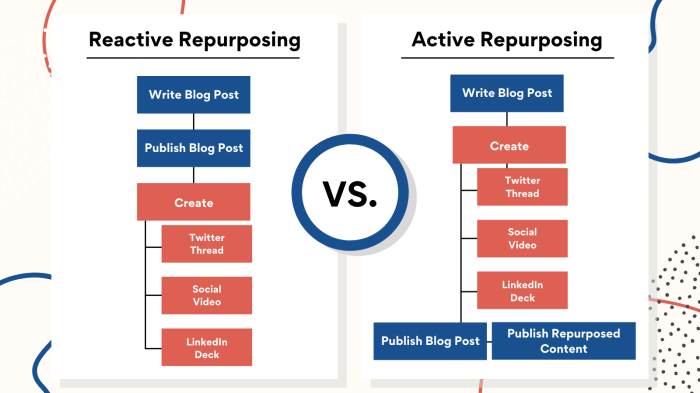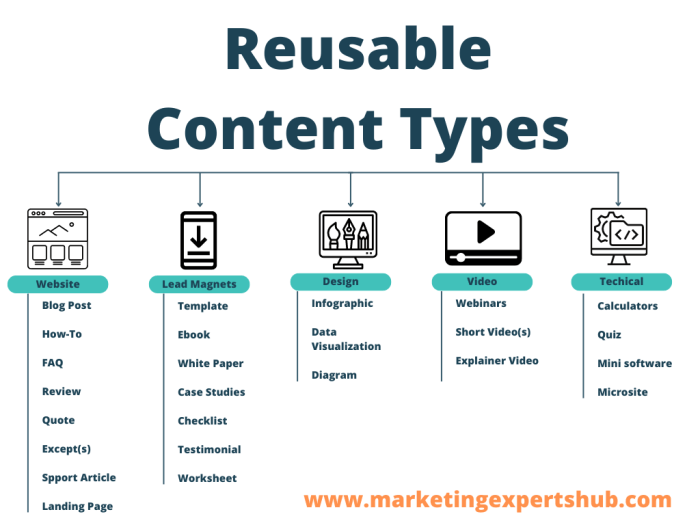Developing a Content Repurposing Plan takes center stage, inviting readers into a world of strategic content creation. Get ready to dive into the realm of repurposing content for maximum digital impact.
From the importance of repurposing to measuring success, this guide has got you covered with all the key insights you need to know.
Importance of Content Repurposing

Content repurposing plays a crucial role in a digital marketing strategy by maximizing the value of existing content, reaching a wider audience, and improving rankings. By repurposing content, brands can extend the lifespan of their content, increase brand visibility, and engage with their audience in new and innovative ways.
Examples of Successful Brands
- BuzzFeed: BuzzFeed is known for repurposing its content across multiple platforms, including articles, videos, and social media posts. By repackaging their content in different formats, they have been able to reach a larger audience and drive more traffic to their website.
- H&M: H&M effectively repurposes its visual content by using images from their clothing campaigns in social media posts, blog articles, and email newsletters. This not only helps them maintain a consistent brand image but also keeps their audience engaged across different channels.
Benefits for and Audience Engagement
- Boost: Repurposing content allows brands to target different s and improve their search engine rankings. By creating new content from existing material, brands can attract more organic traffic to their website.
- Audience Engagement: Repurposing content in various formats such as infographics, podcasts, and videos helps brands cater to different audience preferences. This leads to increased engagement, shares, and overall brand visibility among target audiences.
Steps to Develop a Content Repurposing Plan

To create an effective content repurposing strategy, it is essential to follow key steps that will help maximize the impact of your content across various channels.
Identify Relevant Content
When selecting content to repurpose, focus on pieces that have performed well in the past. Look for evergreen content that can be updated and repackaged to remain relevant to your audience.
Choose the Right Format
Consider the preferences of your target audience when deciding on the format for repurposing content. Whether it’s turning a blog post into a video, or transforming a podcast episode into an infographic, selecting the right format is crucial for engagement.
Maintain Brand Consistency
Consistency is key when repurposing content. Ensure that your brand voice, messaging, and visual elements remain consistent across all repurposed content. This helps in reinforcing brand recognition and loyalty among your audience.
Tools and Technologies for Content Repurposing
Content repurposing can be made easier and more efficient with the help of various tools and technologies specifically designed for this purpose. These tools offer a range of features to streamline the content repurposing process, saving time and effort for content creators.
Popular Tools for Content Repurposing
- Canva: Canva is a popular graphic design tool that allows users to easily create visually appealing graphics, presentations, and social media posts. It can be used to repurpose existing content into eye-catching visuals.
- Hootsuite: Hootsuite is a social media management platform that enables users to schedule posts, monitor social media activity, and engage with followers. It can be utilized to repurpose content across different social media channels.
- Buffer: Buffer is another social media management tool that helps users schedule and analyze social media posts. It can be used to repurpose content and maintain a consistent posting schedule.
Comparison of Software Options, Developing a Content Repurposing Plan
- When comparing software options for content repurposing, consider factors such as user-friendliness, integrations with other tools, pricing, and specific features like templates, scheduling capabilities, and analytics.
- Canva is known for its easy-to-use interface and wide range of design templates, making it ideal for visually repurposing content. Hootsuite and Buffer, on the other hand, focus more on social media management and scheduling, with robust analytics to track performance.
- Ultimately, the choice of software will depend on your specific needs and preferences, so it’s important to explore different options and choose the one that best aligns with your content repurposing goals.
Leveraging Automation for Streamlined Repurposing
Automation plays a key role in streamlining the content repurposing process, allowing you to save time and focus on other aspects of content creation. Here are some tips on how to leverage automation effectively:
- Use scheduling tools to plan and automate the repurposing of content across different platforms, ensuring a consistent posting schedule.
- Set up automated workflows to streamline the process of repurposing content, from design to distribution, reducing manual effort and increasing efficiency.
- Utilize AI-powered tools to analyze data and optimize content performance, helping you make informed decisions on how to repurpose content for better engagement and results.
Measuring Success of Content Repurposing: Developing A Content Repurposing Plan
Tracking the effectiveness of a content repurposing plan is crucial to ensure that your efforts are yielding the desired results. By measuring key metrics and analyzing data, you can optimize your repurposed content for better engagement and conversions.
Key Metrics to Track
When measuring the success of content repurposing, it’s essential to track various key metrics:
- Website Traffic: Monitor the increase in website traffic resulting from repurposed content.
- Engagement: Measure the level of engagement such as likes, shares, comments, and time spent on repurposed content.
- Conversion Rate: Analyze how repurposed content contributes to lead generation and conversion rates.
- Performance: Evaluate the impact of repurposed content on search engine rankings and organic traffic.
Analyzing Data for Optimization
Once you have collected data on key metrics, it’s important to analyze this data to optimize your repurposed content:
- Identify Patterns: Look for patterns in user behavior and engagement to understand what types of repurposed content are resonating with your audience.
- Test Different Formats: Experiment with different formats such as videos, infographics, or podcasts to see what performs best.
- Refine Strategies: Use data insights to refine your content repurposing strategies and focus on what works best for your target audience.
A/B Testing for Better Results
A/B testing is a powerful strategy to improve engagement and conversions with repurposed content:
- Identify Variables: Test different elements of repurposed content, such as headlines, visuals, or calls-to-action, to see which version performs better.
- Set Clear Goals: Define clear goals for your A/B tests and measure the impact of changes on key metrics like conversion rate or engagement.
- Iterate and Optimize: Continuously iterate on your A/B tests based on data insights and optimize your repurposed content for maximum impact.